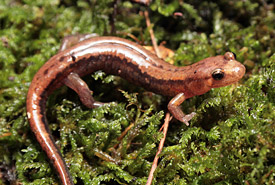How protecting water and land on Covey Hill helps Quebec’s salamanders

Allegheny mountain dusky salamander (Photo by Frédérick Lelièvre, Quebec Government)
Deep in the rolling knolls of the Nature Conservancy of Canada’s (NCC’s) Covey Hill in Quebec are underground water sources, bursting through the land’s surface. These streams and rivers provide habitat for many animals, including all 10 of the salamander species that live in the province.
Not all salamanders are the same. Some live directly in the water their entire life, such as the commons mudpuppy, while others, such as the red-backed salamander, live almost entirely on land.
In the middle of this spectrum are stream salamanders. These salamanders have no lungs, breathing instead through their skin and palate (roof of their mouth). They live close to water and need to keep their skin moist at all times to support their breathing.
Protecting habitat is important in making sure these salamanders have a place to sleep, eat and raise their families. Unfortunately, two of Canada’s four species of stream salamanders are considered to be at risk due to their habitat changing and disappearing. These species are very sensitive to changes in their habitat, including changes in stream flow, and water quality and quantity. Pollution also affects these populations, as unhealthy ecosystems can impact the survival of salamander larvae.
Mountain dusky salamander is a species unique to Quebec, and one that lives at Covey Hill. The springs and streams where this species lives are important to protect to ensure it has a place to find food, reproduce and move around. Mountain dusky salamander can travel dozen of metres away from a stream to find food!
Not only is water important to the survival of these species, but quality forest habitat and well-protected areas between water play a role too. Forest cover keeps soil moist and protects streams from the sun’s rays, which keeps the water from getting too warm for the salamanders.
The 133-acre (54-hectare) peat bog, a wetland with a high volume of moss and decomposing plants, on Covey Hill also helps sustain salamander populations. Stored rainwater between the layers of moss has collected over thousands of years and helps maintain water flow in the area. This is particularly important during periods of drought.
NCC is working to protect habitat for Quebec’s 10 salamander species, including those at risk. In addition to monitoring salamander populations with a recovery team, we’re studying how peatland hydrology — the study of water and how it connects with land — affects water flow in the area.
Learn more on how you can help NCC protect salamander species in Quebec, here.
Thank you to Earth Rangers for helping protect salamander habitat in Covey Hill.


